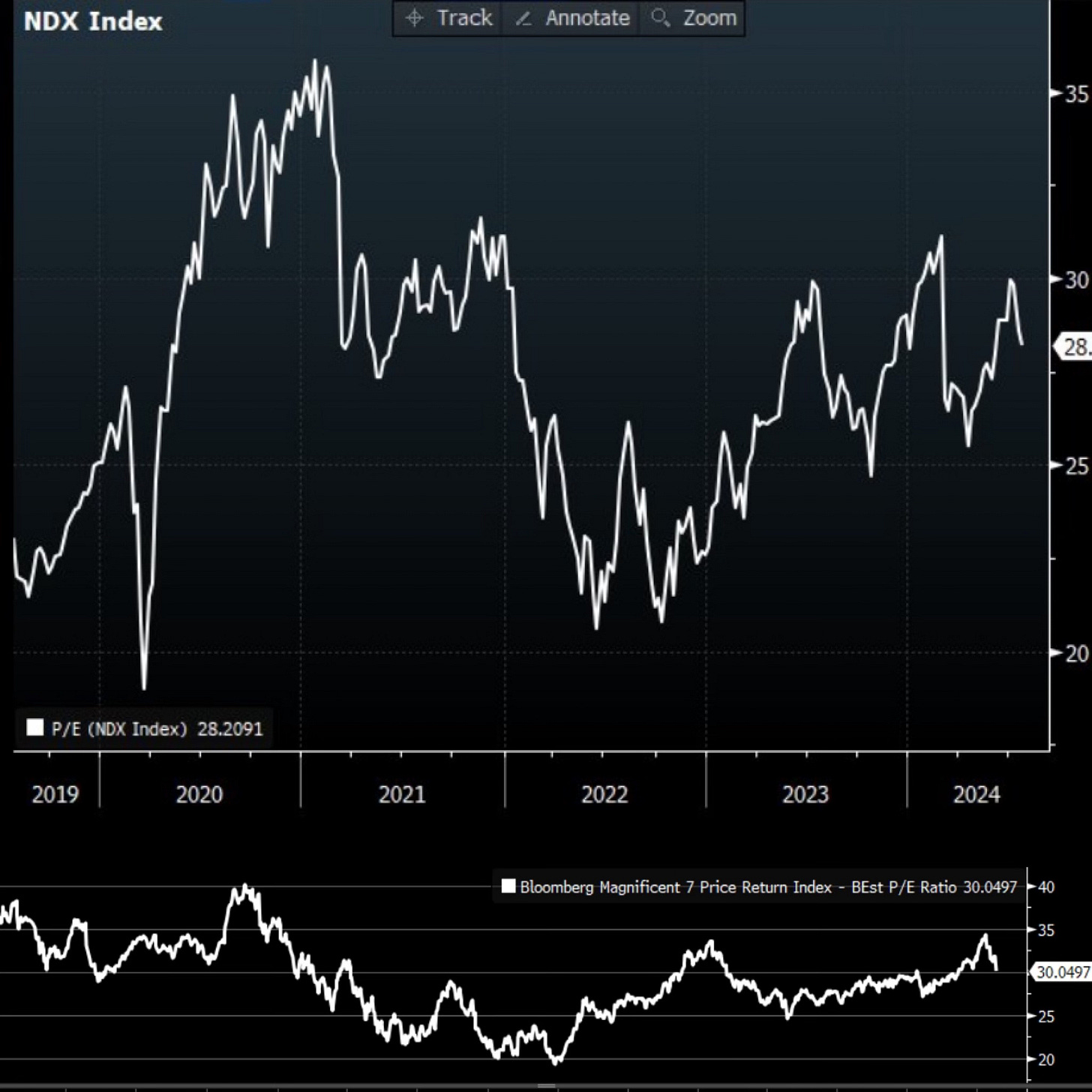As we enter the gauntlet of mega-tech AI stock earnings, it is imperative to scrutinize the current state of the Nasdaq 100 (NDX) and its valuation metrics. The NDX is trading at a lofty price-to-earnings (P/E) ratio of 28 times its estimated earnings per share (EPS) for 2024, reflecting investor optimism as well as one of the most expensive nasdaq markets of all time. However, the sustainability of these valuations is under question, especially given the projected earnings growth rates of 15%, 18%, and 11% for 2024, 2025, and 2026, respectively.
Current Situation
P/E Ratio: The Nasdaq 100 is trading at 28.2 times its estimated EPS for 2024. This high P/E ratio suggests that investors are paying a premium for anticipated future earnings growth. To put this into perspective, if the NDX were to distribute its entire 2024 estimated earnings as dividends annually, it would take 28.2 years to match its current price.
Expected Earnings Growth:
• 2024: 15%
• 2025: 18%
• 2026: 11%
Analysis
High P/E Ratio: A P/E ratio of 28.2 is relatively high, indicating investor confidence in the future earnings potential of the NDX. However, this optimism may be misplaced if the expected earnings growth does not materialize as projected.
Moderate Earnings Growth: The projected earnings growth rates of 15%, 18%, and 11% over the next three years are decent but not extraordinary. For such a high P/E ratio to be justified, the NDX needs to demonstrate stronger-than-expected short-term earnings growth to alleviate pressure on future earnings to meet high market expectations.
Valuation Justification
• P/E Ratio Explained: The P/E ratio measures how much investors are willing to pay for a company’s earnings. A high P/E means high growth expectations.
• The Challenge: If the companies in the Nasdaq 100 don’t grow earnings fast enough, their high stock prices won’t be justified, and prices could fall.
Short-Term Earnings Growth
• Immediate Needs: The companies need to grow their earnings quickly in the short term to justify high stock prices.
• Why It Matters: Strong short-term growth supports the high prices, making investors feel confident they didn’t overpay, even if long-term growth slows down.
In Simple Terms
If you buy an expensive lemon tree expecting lots of lemons soon, you’ll feel overpaid if it doesn’t deliver. Similarly, high stock prices need quick earnings growth to be justified, or prices might drop.
Required Earnings Growth
To maintain the current P/E ratio of 28.2x, the Nasdaq 100’s earnings must grow at a faster rate than currently forecasted. This would entail:
• Higher Annual Growth: Surpassing the expected 15%, 18%, and 11% growth rates.
• Sustained Long-Term Growth: Consistent, robust growth over several years to eventually meet or exceed market expectations.
The necessary stock price increases to sustain the P/E ratio, assuming projected earnings growth, would be:
• 2025: An approximate 14.9% increase.
• 2026: An approximate 16.2% annual increase over two years.
• 2027: An approximate 14.6% annual increase over three years.
If earnings growth falls short, the required stock price increase would need to be higher to sustain the current valuation. For more articles and information on the stock market check out the following previous articles if you haven’t already:
Microsoft: A Case Study in Overvaluation
Despite revenue growth, Microsoft’s stock has not risen sufficiently to justify its current valuation. The stock fell by -8% in after-hours trading and is now down -17% from its high, nearing bear market territory. With a P/E ratio of 36, Microsoft is priced for even greater growth than reported. The company’s forward P/E ratio is also high at 35, suggesting that even though Microsoft is a solid company, its stock price today is risky, especially when the dividend rate is below the risk-free rate of 5% in bonds.
AI Chip Stocks: Overhyped and Underperforming
Lattice Semiconductor (NASDAQ: LSCC): A leader in customer-programmable chips for AI, Lattice reported a -34.7% YoY revenue drop in Q2 CY2024 to $124.1 million. The next quarter’s guidance of $127 million fell short, missing analysts’ estimates by -10.9%. With a P/E ratio of 35, significantly higher than the overall tech market multiple of 29, Lattice’s overvaluation suggests heightened risk, especially in a cyclical industry.
(To Continue reading our in-depth analysis consider being a paid subscriber and get the full breakdown on Part I)
Keep reading with a 7-day free trial
Subscribe to The Coastal Journal to keep reading this post and get 7 days of free access to the full post archives.





